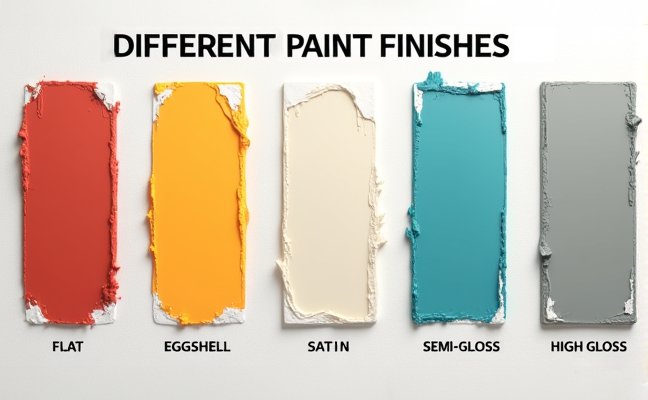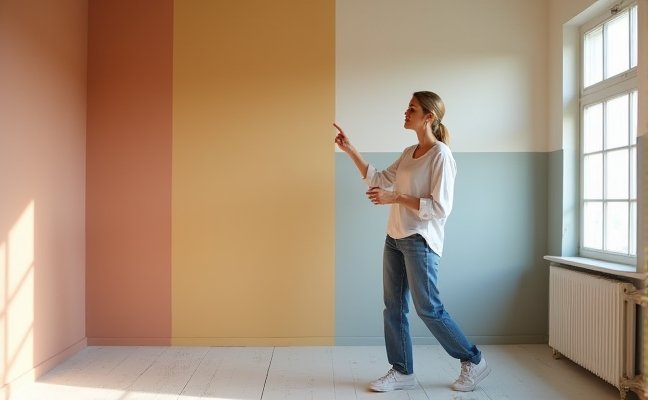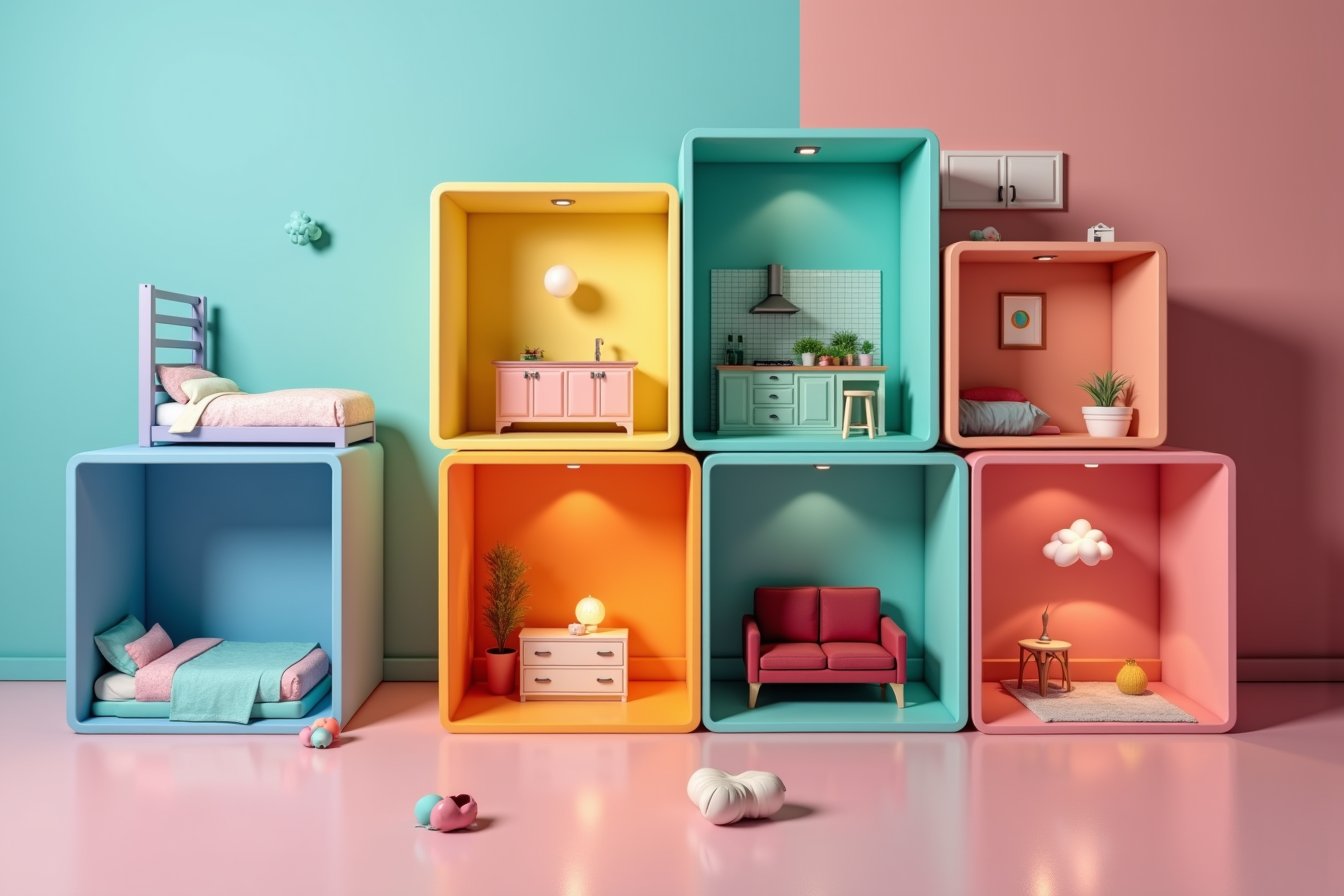How to Choose the Right Paint Finish for Each Room
When it comes to painting your home, choosing the right paint finish is just as important as selecting the perfect color. The paint finish you choose can significantly impact the overall look and feel of a room, as well as its durability and maintenance requirements. In this comprehensive guide, we’ll explore how to select paint finishes for different rooms in your home, ensuring that you make the best choice for each space.
Understanding Different Types of Paint Finishes
Before diving into the specifics of choosing paint finishes for each room, it’s essential to understand the different types of paint finishes available. Each finish has its unique properties and is suited for different purposes. Let’s take a closer look at the most common paint finishes:

Flat (Matte) Finish
Flat finish, also known as matte finish, is non-reflective and perfect for hiding small wall imperfections. It’s ideal for low-traffic areas and rooms where you want to create a soft, subtle look. However, flat finishes are less durable and can be challenging to clean, making them less suitable for high-traffic areas or rooms prone to moisture.
Eggshell Finish
Eggshell finish has a slight sheen, similar to the surface of an eggshell. It offers more durability than flat finishes while still maintaining a relatively low-luster appearance. This finish is a popular choice for living rooms, bedrooms, and dining rooms, as it strikes a balance between aesthetics and practicality.
Satin Finish
Satin finish has a pearl-like sheen that falls between eggshell and semi-gloss. It’s more durable and easier to clean than flat or eggshell finishes, making it suitable for moderate-traffic areas. Satin finish is often used in family rooms, children’s bedrooms, and hallways.
Semi-Gloss Finish
Semi-gloss finish has a noticeable shine and is highly durable and easy to clean. It’s an excellent choice for high-traffic areas, kitchens, bathrooms, and trim work. However, semi-gloss finishes can highlight wall imperfections, so proper surface preparation is crucial.
High Gloss Finish
High gloss finish is the most reflective and durable of all paint finishes. It’s extremely easy to clean and resistant to stains and moisture. While it’s perfect for doors, cabinets, and trim, it’s less commonly used on walls due to its high shine and tendency to highlight imperfections.
Consideration of Room’s Functionality
When choosing paint finishes, it’s crucial to consider the function of each room. Different spaces in your home have varying needs in terms of durability, cleanability, and aesthetics. Let’s explore how to select the best paint finish for rooms based on their functionality:

High-Traffic Areas
For high-traffic areas like kitchens, bathrooms, and hallways, durability and ease of cleaning are paramount. These spaces are prone to moisture, stains, and frequent touching, so choosing a paint finish that can withstand these challenges is essential. Semi-gloss or high gloss finishes are ideal for these areas as they are highly durable and easy to clean. They can withstand frequent wiping and scrubbing without losing their luster or color.
Living Rooms and Bedrooms
In living rooms and bedrooms, where a cozy and relaxing ambiance is desired, flat or eggshell finishes are often the best choice. These finishes create a soft, subtle look that doesn’t reflect light harshly, contributing to a more comfortable atmosphere. Eggshell finish is particularly popular for these spaces as it offers a bit more durability than flat finish while maintaining a low-luster appearance.
Children’s Rooms
When choosing paint finishes for children’s rooms, it’s important to balance durability with aesthetics. Kids’ rooms often see a lot of activity and can be prone to marks and stains. A satin or eggshell finish can be a good compromise, offering some durability and cleanability while still maintaining a softer look than semi-gloss or high gloss finishes.
Home Offices
For home offices, where a professional and focused atmosphere is desired, eggshell or satin finishes are often the best choice. These finishes provide a subtle sheen that can help brighten the space without being too distracting. They’re also durable enough to withstand occasional cleaning and touching.
Room’s Light Exposure
The amount of natural or artificial light a room receives can significantly affect the appearance of the paint finish. When selecting paint finishes, it’s important to consider how light interacts with different sheens and how this can impact the overall look of your space.
Rooms with Plenty of Natural Light
In rooms that receive ample natural light, you have more flexibility in choosing paint finishes. However, it’s important to note that glossier finishes can create glare in bright rooms. If you want to minimize this effect, consider using flat or eggshell finishes, which absorb more light and create a softer look. On the other hand, if you want to maximize the brightness of the room, semi-gloss or high gloss finishes can help reflect light and make the space feel even brighter.
Rooms with Limited Natural Light
For rooms with limited natural light, choosing the right paint finish can help brighten the space. Satin or semi-gloss finishes can help reflect what little light is available, making the room feel brighter and more open. However, be cautious with high gloss finishes in dark rooms, as they can create an uneven appearance due to the strong reflections of limited light sources.
Artificial Lighting Considerations
The type of artificial lighting in a room can also influence how paint finishes appear. Under warm, soft lighting, glossier finishes may appear more subdued. In contrast, under bright, white lighting, these same finishes might appear more reflective. Consider the primary light sources in each room when selecting paint finishes to ensure the final result aligns with your vision.
Wall Surface Condition
The condition of your wall surface is another crucial factor to consider when choosing paint finishes. Different finishes can either hide or highlight wall imperfections, so it’s important to assess your walls before making a decision.
Walls with Imperfections
If your walls have many imperfections such as small cracks, dents, or uneven textures, a flat or matte finish can help hide these flaws. The non-reflective nature of flat finishes doesn’t draw attention to surface irregularities, making them an excellent choice for older homes or walls that haven’t been perfectly prepared. Eggshell finish can also be a good option for slightly imperfect walls, as it provides a bit more durability than flat finish while still concealing minor flaws.
Smooth, Well-Prepared Walls
If you have smooth, well-prepared walls, you have more flexibility in choosing paint finishes. Glossier finishes like satin, semi-gloss, or high gloss can be used to create a sleek, polished look. These finishes can add depth and interest to your walls, but keep in mind that they will also highlight any imperfections that do exist. If you’re considering a glossy finish, it’s worth investing time in proper wall preparation to ensure the best results.
Textured Walls
For textured walls, the choice of paint finish can dramatically affect the final look. Flat or eggshell finishes can help soften the appearance of texture, creating a more subtle effect. On the other hand, glossier finishes can accentuate texture, creating more visual interest but also potentially making the texture more pronounced than desired.
Experimentation is Key
While understanding the properties of different paint finishes and considering factors like room functionality and light exposure is important, there’s no substitute for experimentation when it comes to choosing the right paint finish for each room. Don’t be afraid to try different finishes and see what works best for your space.

Mixing Finishes in One Room
One interesting approach is to use a combination of different finishes in the same room. For example, you might use a flat finish on the ceiling, an eggshell finish on the walls, and a semi-gloss finish on the trim. This can create depth and visual interest while also addressing the specific needs of different surfaces.
Testing Samples
Before committing to a paint finish for an entire room, it’s always a good idea to test samples. Many paint stores offer small sample sizes that you can apply to your walls. Paint a few large swatches of different finishes and observe how they look at different times of day and under various lighting conditions. This can help you make a more informed decision and avoid costly mistakes.
Consider the Overall Design Scheme
When experimenting with paint finishes, consider how they fit into your overall design scheme. For instance, if you’re going for a modern, sleek look, glossier finishes might be more appropriate. For a rustic or farmhouse style, flatter finishes might better suit the aesthetic. The paint finish you choose should complement your furniture, decor, and the overall vibe you’re trying to achieve in each room.
Consult with Professionals
If you’re still unsure about which paint finish to choose for each room, don’t hesitate to consult with professionals. Interior decorators, professional painters, and even knowledgeable staff at paint stores can provide valuable insights based on your specific needs and preferences.
Benefits of Professional Consultation
Professionals can offer expert advice on choosing paint finishes based on factors you might not have considered. They can help you navigate the complexities of different paint finishes, taking into account your home’s unique characteristics, your lifestyle, and your design goals. Moreover, they can often suggest innovative solutions or combinations that you might not have thought of on your own.
Getting a Second Opinion
Even if you feel confident in your choices, getting a second opinion from a professional can be beneficial. They might spot potential issues or offer suggestions to enhance your ideas. Remember, choosing paint finishes is both a science and an art, and professional input can help you achieve the best results.
Maintenance and Durability
Last but not least, when selecting paint finishes for different rooms, it’s crucial to consider maintenance requirements and durability. Your lifestyle, the presence of children or pets, and how frequently you’re willing to repaint or touch up your walls should all factor into your decision.
High-Maintenance vs. Low-Maintenance Finishes
Glossier finishes like semi-gloss and high gloss are generally easier to clean and more durable, making them low-maintenance options for high-traffic areas. However, they may require more careful application and surface preparation. On the other hand, flat finishes are more forgiving during application but can be harder to clean and may require more frequent touch-ups or repainting.
Longevity Considerations
If you’re looking for a long-lasting finish that won’t require frequent repainting, semi-gloss or satin finishes might be your best bet. These finishes are durable enough to withstand regular cleaning and are less likely to show wear and tear over time. However, if you enjoy changing your decor frequently and don’t mind repainting more often, you might prefer the soft look of flat or eggshell finishes, even if they’re less durable.
Balancing Aesthetics and Practicality
Ultimately, choosing the right paint finish for each room involves balancing aesthetics with practicality. While you might love the look of a flat finish in your kitchen, the practical demands of that high-traffic, moisture-prone area might necessitate a more durable option like semi-gloss. Consider each room’s specific needs and how different finishes can meet those needs while still achieving your desired look.
Conclusion
Choosing the right paint finish for each room in your home is a crucial step in creating spaces that are both beautiful and functional. By understanding the properties of different paint finishes, considering room functionality, light exposure, wall condition, and maintenance requirements, you can make informed decisions that will enhance your home’s aesthetic appeal and livability.
Remember, there’s no one-size-fits-all solution when it comes to selecting paint finishes. What works best for one home or room might not be ideal for another. Don’t be afraid to experiment, seek professional advice, and trust your instincts. With careful consideration and a bit of creativity, you can choose paint finishes that will transform your rooms and create the perfect backdrop for your life at home.
As someone who’s gone through the process of selecting paint finishes for my own home, I know how overwhelming it can feel. That’s why I’m excited about simpleHome, a platform that connects homeowners like us with local professionals. Whether you need advice on choosing paint finishes or help with the actual painting, simpleHome can match you with experienced painters and decorators in your area. It’s a great resource for anyone looking to make informed decisions about their home improvement projects.

